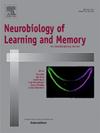The GRIA1 AMPA receptor subunit and selective learning
IF 1.8
4区 心理学
Q3 BEHAVIORAL SCIENCES
引用次数: 0
Abstract
The GRIA1 subunit of the AMPA receptor, encoded by the GRIA1 gene, has been implicated in schizophrenia. Schizophrenia is associated with impairments in attention that may lead to other symptoms due to a failure to learn selectively (e.g., learning about redundant cues). In mice, gene-targeted inactivation of GRIA1 impairs hippocampal synaptic plasticity and alters learning and memory. To test the role of GRIA1 in selective learning, we trained mice lacking GRIA1 on the blocking procedure. GRIA1 knockout mice showed normal blocking of appetitive Pavlovian conditioning, in which prior learning of an auditory cue reduced subsequent acquisition of conditioned responding to a visual cue when the two cues were trained in compound. GRIA1 knockout mice, however, failed to show blocking of flavour preference conditioning despite normal learning of the flavour that, in contrast, was effective in blocking conditioning in control mice. This impairment occurred under conditions in which mice were exposed to one flavour a day and when exposed to two flavours a day to aid discrimination between flavours. The dissociation between learning with visual cues and learning with flavours may suggest that GRIA1 containing AMPA receptors are necessary for selective learning for particular stimulus modalities. Alternatively, GRIA1 may play a role in selective learning when the similarity between cues competing for learning is high, as for flavour preference learning, but not when low, as for auditory and visual cues.
GRIA1 AMPA受体亚基与选择性学习。
由GRIA1基因编码的AMPA受体GRIA1亚基与精神分裂症有关。精神分裂症与注意力障碍有关,注意力障碍可能由于不能选择性地学习(例如,学习多余的线索)而导致其他症状。在小鼠中,基因靶向的GRIA1失活会损害海马突触可塑性并改变学习和记忆。为了测试GRIA1在选择性学习中的作用,我们对缺乏GRIA1的小鼠进行了阻断过程的训练。GRIA1基因敲除小鼠表现出正常的食欲巴甫洛夫条件反射阻滞,即当两种线索被复合训练时,先前对听觉线索的学习减少了随后对视觉线索的条件反应获得。然而,GRIA1基因敲除小鼠未能显示出风味偏好条件反射的阻断,尽管正常的风味学习,相比之下,在对照小鼠中有效地阻断了条件反射。这种损伤发生在老鼠每天接触一种味道和每天接触两种味道以帮助区分味道的条件下。视觉学习和味觉学习之间的分离可能表明,含有AMPA受体的GRIA1对于特定刺激模式的选择性学习是必要的。另外,当竞争学习的线索之间的相似性很高时,GRIA1可能在选择性学习中发挥作用,比如味道偏好学习,但当听觉和视觉线索之间的相似性较低时,GRIA1可能不起作用。
本文章由计算机程序翻译,如有差异,请以英文原文为准。
求助全文
约1分钟内获得全文
求助全文
来源期刊
CiteScore
5.10
自引率
7.40%
发文量
77
审稿时长
12.6 weeks
期刊介绍:
Neurobiology of Learning and Memory publishes articles examining the neurobiological mechanisms underlying learning and memory at all levels of analysis ranging from molecular biology to synaptic and neural plasticity and behavior. We are especially interested in manuscripts that examine the neural circuits and molecular mechanisms underlying learning, memory and plasticity in both experimental animals and human subjects.

 求助内容:
求助内容: 应助结果提醒方式:
应助结果提醒方式:


